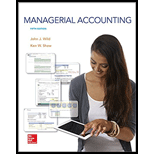
Concept explainers
Concept introduction:
Cost of goods sold (COGS): It relates to the direct costs relating to the production of the goods sold in a company. It also includes the cost of the materials used in developing the good and the direct labour costs used to develop the goods. On the other hand, total expense relates to the sale and manufacturing of the goods produced by the company.
Requirement 1:
Ratio of cost of goods sold(COGS) to total sales of A and S for the two most recent fiscal year.
Concept introduction:
Cost of goods sold (COGS): It relates to the direct costs related to the production of the goods sold in a company. It also includes the cost of the materials used in developing the goodsand the direct labour costs used to develop the goods. On the other hand, total expense relates to the sale and manufacturing of the goods produced by the company.
Requirement 2:
To explain:
Similarities or dissimilarities in the ratio of both the years between the companies.
Want to see the full answer?
Check out a sample textbook solution
Chapter 3 Solutions
MANAGERIAL ACCOUNTING FUND. W/CONNECT
 Essentials of Business Analytics (MindTap Course ...StatisticsISBN:9781305627734Author:Jeffrey D. Camm, James J. Cochran, Michael J. Fry, Jeffrey W. Ohlmann, David R. AndersonPublisher:Cengage Learning
Essentials of Business Analytics (MindTap Course ...StatisticsISBN:9781305627734Author:Jeffrey D. Camm, James J. Cochran, Michael J. Fry, Jeffrey W. Ohlmann, David R. AndersonPublisher:Cengage Learning Principles of Cost AccountingAccountingISBN:9781305087408Author:Edward J. Vanderbeck, Maria R. MitchellPublisher:Cengage Learning
Principles of Cost AccountingAccountingISBN:9781305087408Author:Edward J. Vanderbeck, Maria R. MitchellPublisher:Cengage Learning Cornerstones of Financial AccountingAccountingISBN:9781337690881Author:Jay Rich, Jeff JonesPublisher:Cengage Learning
Cornerstones of Financial AccountingAccountingISBN:9781337690881Author:Jay Rich, Jeff JonesPublisher:Cengage Learning


